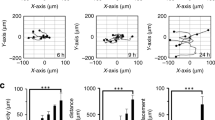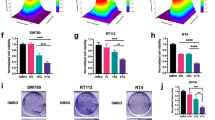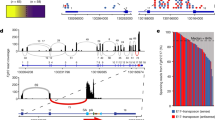Abstract
More than 60% of low-grade non-invasive papillary urothelial cell carcinomas contain activating point mutations of fibroblast growth factor receptor 3 (FGFR3). The phenotypic consequences of constitutive activation of FGFR3 in bladder cancer have not been elucidated and further studies are required to confirm the consequences of inhibiting receptor activity in urothelial cells. We measured FGFR3 transcript levels and demonstrated that transcript levels were significantly more abundant in low-stage and grade tumours. We identified a tumour cell line, 97-7, expressing the most common FGFR3 mutation (S249C) at similar FGFR3 transcript levels to low-stage and grade tumours. In these cells, S249C FGFR3 protein formed stable homodimers and was constitutively phosphorylated. We used retrovirus-mediated delivery of shRNA to knockdown S249C FGFR3. This induced cell flattening, decreased cell proliferation and reduced clonogenicity on plastic and in soft agar. However, no effects of knockdown of wild-type FGFR3 were observed in telomerase immortalized normal human urothelial cells, indicating possible dependence of the tumour cell line on mutant FGFR3. Re-expression of S249C FGFR3 in shRNA-expressing 97-7 cells resulted in a reversal of phenotypic changes, confirming the specificity of the shRNA. These results indicate that targeted inhibition of S249C FGFR3 may represent a useful therapeutic approach in superficial bladder cancer.
This is a preview of subscription content, access via your institution
Access options
Subscribe to this journal
Receive 50 print issues and online access
$259.00 per year
only $5.18 per issue
Buy this article
- Purchase on Springer Link
- Instant access to full article PDF
Prices may be subject to local taxes which are calculated during checkout






Similar content being viewed by others
References
Adar R, Monsonego-Ornan E, David P, Yayon A . (2002). Differential activation of cysteine-substitution mutants of fibroblast growth factor receptor 3 is determined by cysteine localization. J Bone Miner Res 17: 860–868.
Bakkar AA, Wallerand H, Radvanyi F, Lahaye JB, Pissard S, Lecerf L et al. (2003). FGFR3 and TP53 gene mutations define two distinct pathways in urothelial cell carcinoma of the bladder. Cancer Res 63: 8108–8112.
Bernard-Pierrot I, Brams A, Dunois-Larde C, Caillault A, Diez de Medina SG, Cappellen D et al. (2006). Oncogenic properties of the mutated forms of fibroblast growth factor receptor 3b. Carcinogenesis 27: 740–747.
Billerey C, Chopin D, Aubriot-Lorton MH, Ricol D, Gil Diez de Medina S, Van Rhijn B et al. (2001). Frequent FGFR3 mutations in papillary non-invasive bladder (pTa) tumors. Am J Pathol 158: 1955–1959.
Birmingham A, Anderson EM, Reynolds A, Ilsley-Tyree D, Leake D, Fedorov Y et al. (2006). 3′ UTR seed matches, but not overall identity, are associated with RNAi off-targets. Nat Methods 3: 199–204.
Cappellen D, De Oliveira C, Ricol D, de Medina S, Bourdin J, Sastre-Garau X et al. (1999). Frequent activating mutations of FGFR3 in human bladder and cervix carcinomas. Nat Genet 23: 18–20.
Chapman EJ, Hurst CD, Pitt E, Chambers P, Aveyard JS, Knowles MA . (2006). Expression of hTERT immortalises normal human urothelial cells without inactivation of the p16/Rb pathway. Oncogene 25: 5037–5045.
Chen J, Lee BH, Williams IR, Kutok JL, Mitsiades CS, Duclos N et al. (2005). FGFR3 as a therapeutic target of the small molecule inhibitor PKC412 in hematopoietic malignancies. Oncogene 24: 8259–8267.
Chesi M, Bergsagel PL, Kuehl WM . (2002). The enigma of ectopic expression of FGFR3 in multiple myeloma: a critical initiating event or just a target for mutational activation during tumor progression. Current Opinion Hematol 9: 288–293.
Chesi M, Brents LA, Ely SA, Bais C, Robbiani DF, Mesri EA et al. (2001). Activated fibroblast growth factor receptor 3 is an oncogene that contributes to tumor progression in multiple myeloma. Blood 97: 729–736.
Chesi M, Nardini E, Brents LA, Schrock E, Ried T, Kuehl WM et al. (1997). Frequent translocation t(4;14)(p16.3;q32.3) in multiple myeloma is associated with increased expression and activating mutations of fibroblast growth factor receptor 3. Nat Genet 16: 260–264.
Chesi M, Nardini E, Lim RS, Smith KD, Kuehl WM, Bergsagel PL . (1998). The t(4;14) translocation in myeloma dysregulates both FGFR3 and a novel gene, MMSET, resulting in IgH/MMSET hybrid transcripts. Blood 92: 3025–3034.
d’Avis PY, Robertson SC, Meyer AN, Bardwell WM, Webster MK, Donoghue DJ . (1998). Constitutive activation of fibroblast growth factor receptor 3 by mutations responsible for the lethal skeletal dysplasia thanatophoric dysplasia type I. Cell Growth Differ 9: 71–78.
Eswarakumar VP, Lax I, Schlessinger J . (2005). Cellular signaling by fibroblast growth factor receptors. Cytokine Growth Factor Rev 16: 139–149.
Gomez-Roman JJ, Saenz P, Molina M, Cuevas Gonzalez J, Escuredo K, Santa Cruz S et al. (2005). Fibroblast growth factor receptor 3 is overexpressed in urinary tract carcinomas and modulates the neoplastic cell growth. Clin Cancer Res 11: 459.
Grand EK, Chase AJ, Heath C, Rahemtulla A, Cross NC . (2004). Targeting FGFR3 in multiple myeloma: inhibition of t(4;14)-positive cells by SU5402 and PD173074. Leukemia 18: 962–966.
Hart KC, Robertson SC, Donoghue DJ . (2001). Identification of tyrosine residues in constitutively activated fibroblast growth factor receptor 3 involved in mitogenesis, Stat activation, and phosphatidylinositol 3-kinase activation. Mol Biol Cell 12: 931–942.
Hart KC, Robertson SC, Kanemitsu MY, Meyer AN, Tynan JA, Donoghue DJ . (2000). Transformation and Stat activation by derivatives of FGFR1, FGFR3, and FGFR4. Oncogene 19: 3309–3320.
Holmang S, Hedelin H, Anderstrom C, Johansson SL . (1995). The relationship among multiple recurrences, progression and prognosis of patients with stages Ta and T1 transitional cell cancer of the bladder followed for at least 20 years. J Urol 153: 1823–1826; discussion 1826–1827.
Intini D, Baldini L, Fabris S, Lombardi L, Ciceri G, Maiolo AT et al. (2001). Analysis of FGFR3 gene mutations in multiple myeloma patients with t(4;14). Br J Haematol 114: 362–364.
Jebar AH, Hurst CD, Tomlinson DC, Johnston C, Taylor CF, Knowles MA . (2005). FGFR3 and Ras gene mutations are mutually exclusive genetic events in urothelial cell carcinoma. Oncogene 24: 5218–5225.
Keats JJ, Maxwell CA, Taylor BJ, Hendzel MJ, Chesi M, Bergsagel PL et al. (2005). Overexpression of transcripts originating from the MMSET locus characterizes all t(4;14)(p16;q32)-positive multiple myeloma patients. Blood 105: 4060–4069.
Kimura T, Suzuki H, Ohashi T, Asano K, Kiyota H, Eto Y . (2001). The incidence of thanatophoric dysplasia mutations in FGFR3 gene is higher in low-grade or superficial bladder carcinomas. Cancer 92: 2555–2561.
Knowles MA . (2006). Molecular subtypes of bladder cancer: Jekyll and Hyde or chalk and cheese? Carcinogenesis 27: 361–373.
Kurth KH, Denis L, Bouffioux C, Sylvester R, Debruyne FM, Pavone-Macaluso M et al. (1995). Factors affecting recurrence and progression in superficial bladder tumours. Eur J Cancer 31A: 1840–1846.
Logie A, Dunois-Larde C, Rosty C, Levrel O, Blanche M, Ribeiro A et al. (2005). Activating mutations of the tyrosine kinase receptor FGFR3 are associated with benign skin tumors in mice and humans. Human Mol Genetics 14: 1153.
Martinez-Torrecuadrada J, Cifuentes G, Lopez-Serra P, Saenz P, Martinez A, Casal JI . (2005). Targeting the extracellular domain of fibroblast growth factor receptor 3 with human single-chain Fv antibodies inhibits bladder carcinoma cell line proliferation. Clin Cancer Res 11: 6280–6290.
Matsukura S, Jones PA, Takai D . (2003). Establishment of conditional vectors for hairpin siRNA knockdowns. Nucleic Acids Research 31: e77.
Matsumoto M, Ohtsuki Y, Ochii K, Seike Y, Iseda N, Sasaki T et al. (2004). Fibroblast growth factor receptor 3 protein expression in urothelial carcinoma of the urinary bladder, exhibiting no association with low-grade and/or non-invasive lesions. Oncol Rep 12: 967.
Mhawech-Fauceglia P, Cheney RT, Fischer G, Beck A, Herrmann FR . (2006). FGFR3 and p53 protein expressions in patients with pTa and pT1 urothelial bladder cancer. Eur J Surg Oncol 32: 231–237.
Ornitz DM, Xu J, Colvin JS, McEwen DG, MacArthur CA, Coulier F et al. (1996). Receptor specificity of the fibroblast growth factor family. J Biol Chem 271: 15292–15297.
Parkin DM, Bray F, Ferlay J, Pisani P . (2005). Global cancer statistics, 2002. CA Cancer J Clin 55: 74–108.
Paterson JL, Li Z, Wen XY, Masih-Khan E, Chang H, Pollett JB et al. (2004). Preclinical studies of fibroblast growth factor receptor 3 as a therapeutic target in multiple myeloma. Br J Haematol 124: 595–603.
Richelda R, Ronchetti D, Baldini L, Cro L, Viggiano L, Marzella R et al. (1997). A novel chromosomal translocation t(4; 14)(p16.3; q32) in multiple myeloma involves the fibroblast growth-factor receptor 3 gene. Blood 90: 4062–4070.
Ronchetti D, Greco A, Compasso S, Colombo G, Dell’Era P, Otsuki T et al. (2001). Deregulated FGFR3 mutants in multiple myeloma cell lines with t(4;14): comparative analysis of Y373C, K650E and the novel G384D mutations. Oncogene 20: 3553–3562.
Sarkar S, Julicher KP, Burger MS, Della Valle V, Larsen CJ, Yeager TR et al. (2000). Different combinations of genetic/epigenetic alterations inactivate the p53 and pRb pathways in invasive human bladder cancers. Cancer Res 60: 3862–3871.
Scotet E, Houssaint E . (1995). The choice between alternative IIIb and IIIc exons of the FGFR-3 gene is not strictly tissue-specific. Biochim Biophys Acta 1264: 238–242.
Sibley K, Bell S, Knowles MA . (2000). Redefining a critical region of LOH on 4p16.3 in bladder cancer. Genes Chromosomes Cancer 29: 378–379.
Southgate J, Hutton KA, Thomas DF, Trejdosiewicz LK . (1994). Normal human urothelial cells in vitro: proliferation and induction of stratification. Lab Invest 71: 583–594.
Strausberg RL, Simpson AJ, Old LJ, Riggins GJ . (2004). Oncogenomics and the development of new cancer therapies. Nature 429: 469–474.
Tomlinson DC, L’Hote CG, Kennedy W, Pitt E, Knowles MA . (2005). Alternative splicing of fibroblast growth factor receptor 3 produces a secreted isoform that inhibits fibroblast growth factor-induced proliferation and is repressed in urothelial carcinoma cell lines. Cancer Res 65: 10441–10449.
Trudel S, Ely S, Farooqi Y, Affer M, Robbiani DF, Chesi M et al. (2004). Inhibition of fibroblast growth factor receptor 3 induces differentiation and apoptosis in t(4;14) myeloma. Blood 103: 3521–3528.
Trudel S, Li ZH, Wei E, Wiesmann M, Chang H, Chen C et al. (2005). CHIR-258, a novel, multitargeted tyrosine kinase inhibitor for the potential treatment of t(4;14) multiple myeloma. Blood 105: 2941.
Trudel S, Stewart AK, Rom E, Wei E, Li ZH, Kotzer S et al. (2006). The inhibitory anti-FGFR3 antibody, PRO-001, is cytotoxic to t(4;14) multiple myeloma cells. Blood 107: 4039–4046.
van Rhijn BW, Lurkin I, Chopin DK, Kirkels WJ, Thiery JP, van der Kwast TH et al. (2003). Combined microsatellite and FGFR3 mutation analysis enables a highly sensitive detection of urothelial cell carcinoma in voided urine. Clin Cancer Res 9: 257–263.
van Rhijn BW, Lurkin I, Radvanyi F, Kirkels WJ, van der Kwast TH, Zwarthoff EC . (2001). The fibroblast growth factor receptor 3 (FGFR3) mutation is a strong indicator of superficial bladder cancer with low recurrence rate. Cancer Res 61: 1265–1268.
Voorhoeve PM, Agami R . (2003). The tumor-suppressive functions of the human INK4A locus. Cancer Cell 4: 311–319.
Webster MK, Donoghue DJ . (1997). FGFR activation in skeletal disorders: too much of a good thing. Trends Genet 13: 178–182.
Weinstein IB . (2002). Cancer. Addiction to oncogenes – the Achilles heal of cancer. Science 297: 63–64.
Wu XR . (2005). Urothelial tumorigenesis: a tale of divergent pathways. Nat Rev Cancer 5: 713–725.
Zhu L, Somlo G, Zhou B, Shao J, Bedell V, Slovak ML et al. (2005). Fibroblast growth factor receptor 3 inhibition by short hairpin RNAs leads to apoptosis in multiple myeloma. Mol Cancer Ther 4: 787.
Acknowledgements
We thank Dr Catherine Reznikoff for generously providing the cell lines 97-7, 97-18, 97-29, 96-1, 97-24 and 97-1, Dr D Podolsky for providing FGFR3b cDNA, Dr R Agami for pRS-hyg and Dr Eva Pitt for excellent tissue culture support. This work was funded by Cancer Research UK.
Author information
Authors and Affiliations
Corresponding author
Rights and permissions
About this article
Cite this article
Tomlinson, D., Hurst, C. & Knowles, M. Knockdown by shRNA identifies S249C mutant FGFR3 as a potential therapeutic target in bladder cancer. Oncogene 26, 5889–5899 (2007). https://doi.org/10.1038/sj.onc.1210399
Received:
Revised:
Accepted:
Published:
Issue Date:
DOI: https://doi.org/10.1038/sj.onc.1210399
Keywords
This article is cited by
-
APOBEC3-mediated mutagenesis in cancer: causes, clinical significance and therapeutic potential
Journal of Hematology & Oncology (2023)
-
Downregulation of CBX7 induced by EZH2 upregulates FGFR3 expression to reduce sensitivity to cisplatin in bladder cancer
British Journal of Cancer (2023)
-
ETV5 links the FGFR3 and Hippo signalling pathways in bladder cancer
Scientific Reports (2019)
-
Mutational profiling can identify laryngeal dysplasia at risk of progression to invasive carcinoma
Scientific Reports (2018)
-
Exploring the FGFR3-related oncogenic mechanism in bladder cancer using bioinformatics strategy
World Journal of Surgical Oncology (2017)



